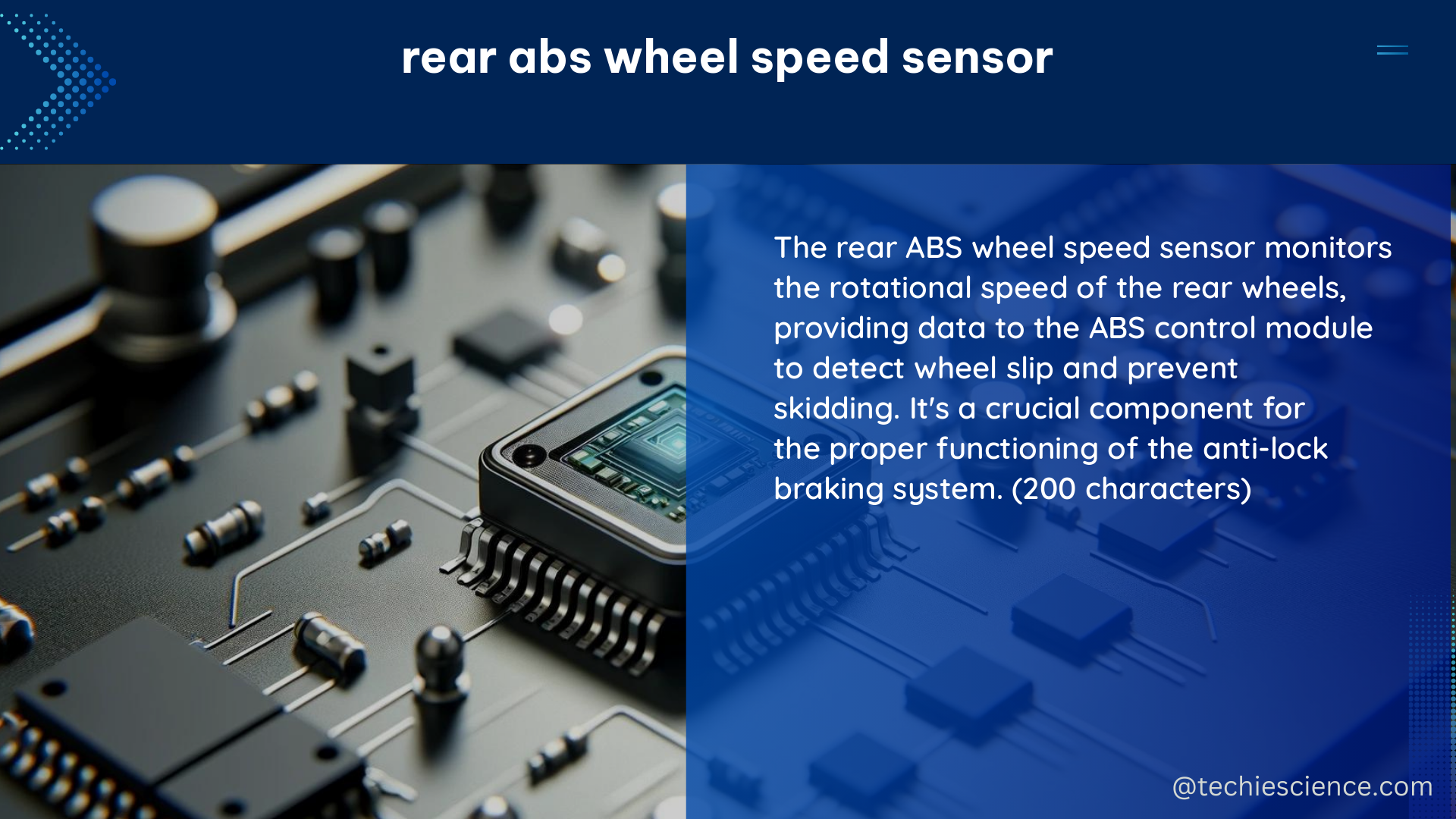The rear ABS wheel speed sensor is a critical component in a vehicle’s anti-lock braking system (ABS), responsible for monitoring the rotational speed of the rear wheels and transmitting this information to the ABS control module. This data is essential for the ABS system to function properly, preventing wheel lockup during hard braking and maintaining traction and steering control.
Understanding the Rear ABS Wheel Speed Sensor
The rear ABS wheel speed sensor is typically a Hall effect sensor, which generates a small voltage variation as a wheel tooth passes by. The ABS module compares the frequency of the waveform output by the sensors at each wheel to determine their rotational speed relative to each other. If the frequency measured at one wheel differs from the other wheels beyond a pre-determined threshold, the system pulses the brake line pressure to that wheel.
Technical Specifications
The technical specifications of a rear ABS wheel speed sensor can vary depending on the vehicle make and model, but some common specifications include:
| Specification | Range |
|---|---|
| Voltage Output (Passive Sensors) | 0.5 to 1 volt AC |
| Resistance (Passive and Active Sensors) | 1,000 to 2,500 ohms |
| Signal Tracking | The sensor should produce a clean signal that tracks the same as other sensors and evenly drops when the vehicle is stopped. |
It’s important to note that the sensor should be capable of producing a consistent and reliable signal to ensure accurate ABS operation.
Testing the Rear ABS Wheel Speed Sensor
When testing a passive wheel speed sensor, the following steps should be followed:
- Disconnect the sensor and/or harness from the circuit.
- Connect the positive lead of the multimeter to the signal wire.
- Connect the negative lead of the multimeter to the ground or a chassis ground, depending on the test being performed.
- Measure the resistance of the sensor to ensure it falls within the specified range.
By disconnecting the sensor from the circuit, you can accurately measure the resistance without any interference from the ABS module or other components.
Troubleshooting Faulty Sensors
In some cases, a faulty ABS wheel speed sensor may cause unwanted ABS activations, especially in passive sensors. This can be due to rust or corrosion between the sensor and the knuckle or hub, which can disturb the air gap between the sensor and the tone ring. In such cases, clearing the rust and polishing the surface may resolve the problem.
However, if the tone wheel or other electrical outputs are causing interference, further investigation may be necessary. This could involve checking the tone wheel for damage, inspecting the wiring harness for any signs of wear or damage, and ensuring proper grounding of the sensor.
Importance of Proper Maintenance

The rear ABS wheel speed sensor is a vital component in a vehicle’s ABS system, and its technical specifications should be understood to ensure accurate measurement and diagnosis. Proper testing and maintenance can help prevent unwanted ABS activations and ensure safe driving.
Regular inspection and replacement of the rear ABS wheel speed sensor, as recommended by the vehicle manufacturer, can help maintain the sensor’s performance and reliability. This can include checking for proper sensor alignment, cleaning the sensor and tone ring, and replacing the sensor if it is found to be faulty.
Conclusion
The rear ABS wheel speed sensor is a critical component in a vehicle’s anti-lock braking system, responsible for monitoring the rotational speed of the rear wheels and providing this information to the ABS control module. Understanding the technical specifications, testing procedures, and troubleshooting techniques for this sensor is essential for maintaining the proper operation of the ABS system and ensuring safe driving.
References:
– Does polarity matter on ABS wheel speed sensor?
– Wheel Speed Sensor Diagnostics for Meters and Scopes
– Check & change ABS sensor

The lambdageeks.com Core SME Team is a group of experienced subject matter experts from diverse scientific and technical fields including Physics, Chemistry, Technology,Electronics & Electrical Engineering, Automotive, Mechanical Engineering. Our team collaborates to create high-quality, well-researched articles on a wide range of science and technology topics for the lambdageeks.com website.
All Our Senior SME are having more than 7 Years of experience in the respective fields . They are either Working Industry Professionals or assocaited With different Universities. Refer Our Authors Page to get to know About our Core SMEs.